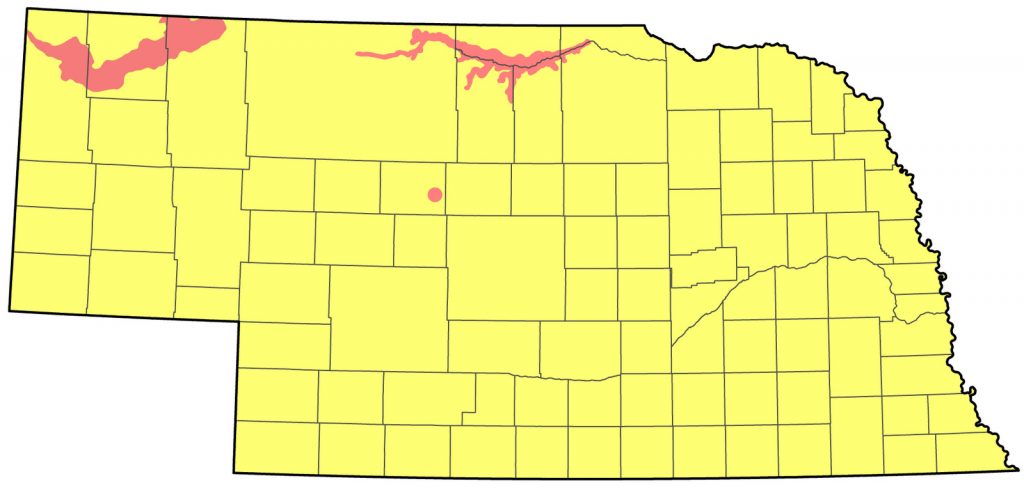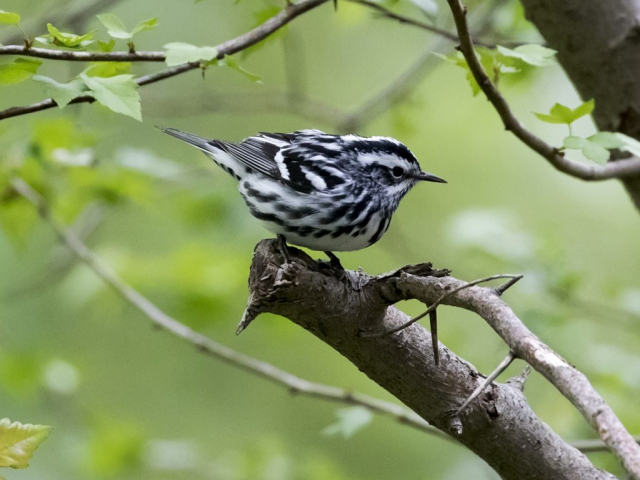Mniotilta varia
Status: Fairly common regular spring and fall migrant statewide. Uncommon regular breeder north and northwest.

Documentation: Specimen: UNSM ZM6797, 6 May 1901 Child’s Point, Sarpy Co.
Taxonomy: No subspecies are currently recognized (AviList 2025).
Spring: Apr 23, 23, 23 <<<>>> summer (east, central); May 4, 6, 6 <<<>>> summer (west)
Earlier dates (east, central) are 24 Mar (Rosche 1994), 4 Apr 2020 Sarpy Co, 8 Apr 2015 Cherry Co, 16 Apr 2025 Jefferson Co, and 20 Apr 2013 Lancaster Co.
An earlier date (west) is 27 Apr 2022 Cheyenne Co.
Presumed late spring migrants away from breeding areas were 2 Jun 2014 Valentine NWR, Cherry Co, 4 Jun 2014 Platte River SP, Cass Co, and 5 Jun 1996 Indian Cave SP, Richardson Co.
For breeding season (6 Jun-13 Aug) dates away from breeding areas see Fall (below).
Migration begins in late Apr, somewhat earlier in the east, and ends by late May, although sightings as late as mid-Jun may be of migrants. Peak numbers occur mid-May. Arrival is somewhat later in the Panhandle.
Migrants occur statewide, although numbers are lower westward; Rosche (1982) considered this species uncommon in the northwest.
- High counts: 110 in Sarpy Co 11 May 1996, including 58 at Fontenelle Forest, 17 at Wayne, Wayne Co 22 May 2025, 16 in Lancaster Co 10 May 1996, 16 at Walnut Grove Park, Omaha, Douglas Co 9 May 2009, and 13 at Fontenelle Forest 14 May 2016.
Summer: Short (1961) summarized the breeding status of Black-and-white Warbler as “Probably most common … along the relatively well-wooded Niobrara River, in the Missouri Valley area and in parts of northwestern Nebraska.” Since then, breeding season reports in the Missouri River Valley are few and restricted to the northeast, but the species still breeds fairly commonly in the Niobrara River Valley and on the Pine Ridge.
Largest numbers occur in the Niobrara River Valley, where Brogie and Mossman (1983) found “numerous singing males and territorial birds” during the summer of 1982 in the Niobrara Valley Preserve, where it apparently has bred regularly for many years (Bruner et al 1904). It occurs west to Cherry Co, where there are summer records 2 Jun 2014 Valentine NWR, 14 Jun 2016 Road 16F Niobrara River river crossing, 9-16 Jun 1985, 16 Jun 1977, mid-Jun 2006, and 12 Jun 2004 at NNF McKelvie. Mollhoff (2001) showed a “probable” breeding record along the Niobrara River in the Valentine area, and the second BBA (Mollhoff 2016) showed a marked increase in reports from the same area, west approximately to the Road 16F river crossing in central Cherry Co. To the east, singles were at Long Pine WMA, Rock Co 15 Jun 2017 and just to the north at a church camp 7 Jun 2007; Hutton Sanctuary, Rock Co hosted singles 6 Jun 2014 and 5 Jun 2015, and three on 11 Jun 2022.
On the Pine Ridge, the second BBA (Mollhoff 2016) showed an increase in reports compared with the first atlas (Mollhoff 2001); there were none east of Dawes Co, however. Rosche (1982) described this species as an “uncommon summer visitant” which “presumably breeds” on the Pine Ridge in Sioux and Dawes Cos; since then there have been summer reports for Sheridan Co 19-29 Jun 1985 and 4 Jun 1986. A pair of adults feeding just-fledged young were at Coffee Park, Sioux Co 12 Jun 1979, and two different females were carrying food in Monroe Canyon, Sioux Co 14 Jun 2003. An adult male was feeding a begging fledgling in West Ash Canyon, Dawes Co, 28 Jun 2006 (Mollhoff 2006).
Elsewhere, the only confirmed breeding occurred in Thomas Co, where Ford (1959) stated that on “several occasions we observed adults feeding fledglings” in 1957 along the Middle Loup River. Short’s 1957 specimens, 3 males and a juvenile collected 5-9 Jul at NNF Halsey, are #34106, #34107, #34109, and #34110 at the University of Kansas Institute Biodiversity Institute, Lawrence (Mollhoff 2022). Short (1961) found it common there in 1955 also, and there is a set of eggs at UNSM collected 4 Jun in Thomas Co. Singles were at NNF Halsey 11 Jun 1986 and 30 Jun 2019; reports of two there 3 Jun 2017 and one on 6 Jun 2022 may have been migrants.
In the northeast, most reports are from Dixon and Cedar Cos, although breeding is as yet unconfirmed. At Ponca SP in Dixon Co, there are about 13 reports 7 Jun-23 Jul beginning in 2017, including four birds on 7 Jun 2022. Singles were at nearby Mulberry Bend, Dixon Co 17 Jun 2020 and 9 Jun 2021. Singles have been reported in Cedar Co along the Missouri River 10 Jun 2013 and 14 Jul 2018, at Wiseman WMA 11 Jun 2018, Bow Creek RA 8 Jun 2021 and 17 Jun 2022, and at 575 Ave and 889 Road 9 Jun 2022. Isolated records from neighboring counties are 1 Jul 2006 along 881 Road, Knox Co, at Ashford Scout Camp in Thurston Co 8 Jun 1985, 10 Jun 2024 Thurston Co, and one in Dakota Co 23 Jun 2025.
Evidence for current breeding in the Missouri River Valley south of Thurston Co is lacking; there are no records of nesting since 1900 (Ducey 1988, Bruner et al 1904), although Rapp et al (1958) described it as a “local and uncommon summer resident”, without specific records. Mollhoff (2016) mapped a “Probable” report in southwestern Sarpy Co, and “Observed” and “Possible” reports in extreme northeast Sarpy Co, during 2006-2011. Breeding season reports (6 Jun-13 Aug) in Missouri River Valley areas are listed below under Fall; multiple reports suggestive of occasional breeding are from Sarpy, Cass, Nemaha, and Richardson Cos.
There are several reports away from known breeding areas 6 Jun-13 Aug. For dates, see Fall (below).
- Breeding phenology:
- Nest building: 21 May (Mollhoff 2022)
- Eggs: 4 Jun (Mollhoff 2022)
- Nestlings: 7 Jun
- Fledglings: 12-28 Jun
Fall: Aug 14, 15, 16 <<<>>> Oct 4, 6, 7
Early dates above are away from breeding areas. Adults may leave breeding areas as early as late Jun, as in Ontario, and by mid-late Jul in Alberta (Kricher 2020).
Additional breeding season (6 Jun-13 Aug) reports where breeding is unlikely are 10 Jun 2017 Garden Co; 19 Jul 2025 Knox Co, 15 Jun Keith Co (Brown et al 1996); 16 Jun 2024 Hiatt Wetlands and 3 Jul 1981 Lincoln Co; 13 Jun 2015, 10 Jul 2023, and 8 Aug 2019 Buffalo Co; 20 Jun-1 Jul 1988 and 1 Jul 1965 Adams Co; 5 Aug 2017 Webster Co; 14 Jun 2008 and 17 Jun 2015 Douglas Co; 5 Jul 1982 (Williams 1982), 7 Jul 2011, 21 Jul 1995, 22 Jul 2017, and 23 Jul 1969 Sarpy Co; 26-28 Jul 2020 Cass Co; 2 Jul 1987, 17 Jul 2016, and 31 Jul 2020 Lancaster Co; 20 Jun 2016 Johnson Co; 4 Aug 2016 Nemaha Co; 11 Jun 2017, 13 Jun 2011, 13 Jun 2020, 17 Jun 2006, 30 Jun 2003, and 4 Aug 2016 Richardson Co.
General arrival is in late Aug and departure is completed by early Oct.
Later dates are 12 Oct 2011 Dodge Co, 28 Oct-2 Nov 2001 Scottsbluff, Scotts Bluff Co, 2 Nov 2021 Gotte Park, Kimball Co, 10 Nov 1972 Douglas Co (Williams 1973), and an extremely late report of one possibly attempting to over-winter 25 Jan 1981 Sarpy Co (Williams 1981).
- High counts: 14 at Krimlofski Tract, Neale Woods, Washington Co 13 Sep 1998, 11 at Bellevue, Sarpy Co 26 Aug 2006, and 10 at Ponca SP, Dixon Co 3 Sep 1996.
Images
Abbreviations
BBA: Breeding Bird Atlas
NNF: Nebraska National Forest
RA: Recreation Area
NWR: National Wildlife Refuge
SP: State Park
UNSM: University of Nebraska State Museum
Literature Cited
AviList Core Team, 2025. AviList: The Global Avian Checklist, v2025. https://doi.org/10.2173/avilist.v2025.
Brogie, M.A., and M.J. Mossman. 1983. Spring and summer birds of the Niobrara Valley Preserve, Nebraska: An annotated checklist. NBR 51: 44-51.
Brown, C.R., M.B. Brown, P.A. Johnsgard, J. Kren, and W.C. Scharf. 1996. Birds of the Cedar Point Biological Station area, Keith and Garden Counties, Nebraska: Seasonal occurrence and breeding data. Transactions of the Nebraska Academy of Sciences 23: 91-108.
Bruner, L., R.H. Wolcott, and M.H. Swenk. 1904. A preliminary review of the birds of Nebraska, with synopses. Klopp and Bartlett, Omaha, Nebraska, USA.
Ducey, J.E. 1988. Nebraska birds, breeding status and distribution. Simmons-Boardman Books, Omaha, Nebraska, USA.
Ford, N.L. 1959. Notes on summer birds of western Nebraska. NBR 27: 6-12.
Kricher, J.C. 2020. Black-and-white Warbler (Mniotilta varia), version 1.0. In Birds of the World (A. F. Poole, Editor). Cornell Lab of Ornithology, Ithaca, NY, USA. https://doi.org/10.2173/bow.bawwar.01.
Mollhoff, W.J. 2001. The Nebraska Breeding Bird Atlas 1984-1989. Nebraska Ornithologists’ Union Occasional Papers No. 7. Nebraska Game and Parks Commission, Lincoln, Nebraska, USA.
Mollhoff, W.J. 2006. The 2006 Nebraska nest report. NBR 74: 142-147.
Mollhoff, W.J. 2016. The Second Nebraska Breeding Bird Atlas. Bull. Univ. Nebraska State Museum Vol 29. University of Nebraska State Museum, Lincoln, Nebraska, USA.
Mollhoff, W.J. 2022. Nest records of Nebraska birds. Nebraska Ornithologists’ Union Occasional Paper Number 9.
Rapp, W.F. Jr., J.L.C. Rapp, H.E. Baumgarten, and R.A. Moser. 1958. Revised checklist of Nebraska birds. Occasional Papers 5, Nebraska Ornithologists’ Union, Crete, Nebraska, USA.
Rosche, R.C. 1982. Birds of northwestern Nebraska and southwestern South Dakota, an annotated checklist. Cottonwood Press, Crawford, Nebraska, USA.
Rosche, R.C. 1994. Birds of the Lake McConaughy area and the North Platte River valley, Nebraska. Published by the author, Chadron, Nebraska, USA.
Short, L.L., Jr. 1961. Notes on bird distribution in the central Plains. NBR 29: 2-22.
Williams, F. 1973. Southern Great Plains Region. American Birds 27: 78-82.
Williams, F. 1981. Southern Great Plains Region. American Birds 35: 313-315.
Williams, F. 1982. Southern Great Plains Region. American Birds 36: 992-995.
Recommended Citation
Silcock, W.R., and J.G. Jorgensen. 2025. Black-and-white Warbler (Mniotilta varia). In Birds of Nebraska — Online. www.BirdsofNebraska.org
Updated 1 Sep 2025
